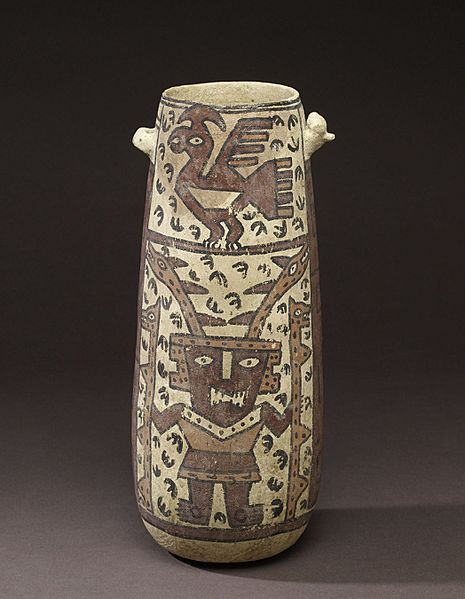Image: Chancay - Vessel - Walters 20092035 - Back

Description: The Chancay art style dominated Peru's Central Coast during the Late Intermediate Period, although there was no centralized, overarching state authority ruling the region. Textiles and pottery were the primary artistic media, the former being among the most colorful, visually complex, and technically excellent weavings ever produced in Peru. Chancay pottery, on the other hand, is often rather casually or carelessly painted, its slip characterized by a matte surface finish and a palette restricted to white and black (with the infrequent addition of red or beige). The low-fired Chancay ceramics make them susceptible to surface damage, unlike the earlier pottery of the Moche, Nasca, and Waricultures. On the other hand, Chancay painting can be as lively as that of any Andean tradition. The acute difference in quality between Chancay ceramics and textiles reflects sociopolitical divisions in Chancay culture. Burial patterns indicate that the painted ceramics were consumed by all levels of Chancay society, whereas fine textiles and precious metal objects were restricted to members of higher status. As elsewhere in the Andean world, artistic quality and materials conveyed messages of hierarchy and power. This tall, narrow vessel features the frontal rendering of a male figure. He grasps a puma-headed staff in each hand, and two serpent-headed rays emanate from his head. These pan-Andean features link the figure to traditional depictions of supernatural beings or deities and shamans. The bird painted at the top of the vessel reflects this theme in its crescent-shaped head adornment, which distinguishes the "Sicán Deity" or "Sicán Lord," who may be a culture hero or a deity among cultures to the north. The "Sicán Lord" is associated primarily with the Sicán and later Chimú societies of the North Coast, although the Chimú extended their influence over the Chancay people at the end of the Late Intermediate Period. It is not improbable that this symbol of divinity and/or sacred ancestry was adopted by the Chancay. The painter of this tall vessel animated the scene by filling the background with black avian footprints, which, at the least, lend motion to the bird if not implying its ritual performance.
Title: Vessel
Credit: Walters Art Museum: Home page Info about artwork
Author: Anonymous (Chancay)Unknown author
Permission: This work is free and may be used by anyone for any purpose. If you wish to use this content, you do not need to request permission as long as you follow any licensing requirements mentioned on this page. The Wikimedia Foundation has received an e-mail confirming that the copyright holder has approved publication under the terms mentioned on this page. This correspondence has been reviewed by a Volunteer Response Team (VRT) member and stored in our permission archive. The correspondence is available to trusted volunteers as ticket #2012021710000834. If you have questions about the archived correspondence, please use the VRT noticeboard. Ticket link: https://ticket.wikimedia.org/otrs/index.pl?Action=AgentTicketZoom&TicketNumber=2012021710000834 Find other files from the same ticket:
Usage Terms: Public domain
License: Public domain
Attribution Required?: No
Image usage
The following page links to this image:

